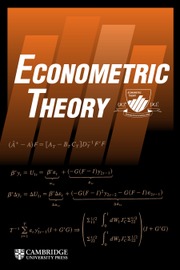Article contents
IDENTIFICATION AND INFERENCE IN A QUANTILE REGRESSION DISCONTINUITY DESIGN UNDER RANK SIMILARITY WITH COVARIATES
Published online by Cambridge University Press: 02 August 2023
Abstract
This study investigates the identification and inference of quantile treatment effects (QTEs) in a fuzzy regression discontinuity (RD) design under rank similarity. Unlike Frandsen et al. (2012, Journal of Econometrics 168, 382–395), who focus on QTEs only for the compliant subpopulation, our approach can identify QTEs and average treatment effect for the whole population at the threshold. We derived a new set of moment restrictions for the RD model by imposing a local rank similarity condition, which restricts the evolution of individual ranks across treatment status in a neighborhood around the threshold. Based on the moment restrictions, we derive closed-form solutions for the estimands of the potential outcome cumulative distribution functions for the whole population. We demonstrate the functional central limit theorems and bootstrap validity results for the QTE estimators by explicitly accounting for observed covariates. In particular, we develop a multiplier bootstrap-based inference method with robustness against large bandwidths that applies to uniform inference by extending the recent work of Chiang et al. (2019, Journal of Econometrics 211, 589–618). We also propose a test for the local rank similarity assumption. To illustrate the estimation approach and its properties, we provide a simulation study and estimate the impacts of India’s 40-billion-dollar national rural road construction program on the reallocation of labor out of agriculture.
Information
- Type
- ARTICLES
- Information
- Copyright
- © The Author(s), 2023. Published by Cambridge University Press
Footnotes
The four authors contributed to the paper equally. We are grateful to the Editor (Peter C.B. Phillips), the Co-Editor, and two anonymous referees for their very useful and insightful comments. This research is supported by the National Science Foundation of China (Grant Nos. 72103126, 71873080, 72273076, and 71833004) and the Fundamental Research Funds for the Central Universities (Grant No. 2023110077).
References
REFERENCES
- 1
- Cited by

